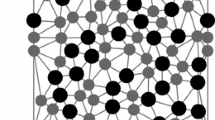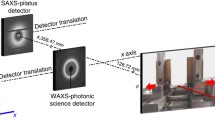Abstract
A hierarchical modelling scheme to predict the properties of a polymer matrix composite is introduced. The stress–strain curves of amine-cured tetraglycidyl 4,4′-diaminodiphenylmethane (TGDDM) cured have been predicted using group interaction modelling (GIM). The GIM method, originally applied primarily to linear polymers, has been significantly extended to give accurate, consistent results for TGDDM, a highly crosslinked two-component matrix. The model predicts a complete range of temperature-dependent properties, from fundamental energy contributions, through engineering moduli to full stress–strain curves through yield. The predicted properties compare very well with experiment. Using the GIM-predicted TGDDM stress–strain curve, a 3D finite element model is used to obtain strain concentration factors (SCF) of fibres adjacent to a fibre break in a unidirectional (UD) composite. The strain distribution among the intact neighbouring fibres is clearly affected by the yielding mechanism in the resin matrix. A Monte Carlo simulation is carried out to predict the tensile failure strain of a single composite layer with the thickness equal to the fibre ineffective length. The effect of matrix shear yielding is introduced to the model through the SCF of surviving fibres adjacent to the fibre-break. The tensile failure strain of the composite is then predicted using a statistical model of a chain of composite layers.










Similar content being viewed by others
References
Pham HQ, Marks MJ (2002) Epoxy resins. In: Encyclopedia of polymer science and technology. Wiley
Gupta A, Cizmecioglu M, Coulter D, Liang RH, Yavrouian A, Tsay FD, Moacanin J (1983) J Appl Polym Sci 28:1011. doi:https://doi.org/10.1002/app. 1983.070280309
Jones FR (2005) In: Soutis C, Beaumont PWR (eds) Multi-scale modelling of composite material systems: the art of predictive damage modelling. Woodhead publishing limited, Cambridge, p 528
Porter D (1995) Group interaction modelling of polymer properties. Marcel Dekker, New York
Foreman JP, Porter D, Behzadi S, Travis KP, Jones FR (2006) J Mater Sci 41:6631. doi:https://doi.org/10.1007/s10853-006-0202-9
Gumen VR, Jones FR, Attwood D (2001) Polymer 42:5717. doi:https://doi.org/10.1016/S0032-3861(00)00930-7
Liu HP, Uhlherr A, Bannister MK (2004) Polymer 45:2051. doi:https://doi.org/10.1016/j.polymer.2004.01.008
Porter D, Vollrath F, Shao Z (2005) Eur Phys J E 16:199. doi:https://doi.org/10.1140/epje/e2005-00021-2
Vollrath F, Porter D (2006) Appl Phys A-Mater Sci Process 82:205. doi:https://doi.org/10.1007/s00339-005-3437-4
Rosen BW (1964) AIAA J 2:1985
Zweben C (1968) AIAA J 6:2325
Zweben C, Rosen W (1970) J Mech Phys Solids 18:189. doi:https://doi.org/10.1016/0022-5096(70)90023-2
Lane R, Hayes SA, Jones FR (2001) Compos Sci Technol 61:565. doi:https://doi.org/10.1016/S0266-3538(00)00229-3
Behzadi S, Curtis PT, Jones FR (2007) Proceedings of ICCM-16, Kyoto
Hedgepeth JM, van Dyke P (1967) J Compos Mater 1:294
Wada A, Fukuda H (1999) Compos Sci Technol 59:89. doi:https://doi.org/10.1016/S0266-3538(98)00052-9
LienKamp M, Schwartz P (1993) Compos Sci Technol 46:139. doi:https://doi.org/10.1016/0266-3538(93)90169-H
Fukuda H, Kawata K (1977) Fibre Sci Technol 10:53. doi:https://doi.org/10.1016/0015-0568(77)90028-8
Manders PW, Bader MG, Chou TW (1982) Fibre Sci Technol 17:183. doi:https://doi.org/10.1016/0015-0568(82)90003-3
Ochiai S, Osamura K (1988) J of Mater Sci 23:886. doi:https://doi.org/10.1007/BF01153984
Curtin WA, Takeda N (1998) J Compos Mater 32:2060
Curtis PT (1986) Compos Sci Technol 27:63. doi:https://doi.org/10.1016/0266-3538(86)90063-1
Williams JG (1979) J Appl Polym Sci 23:3433. doi:https://doi.org/10.1002/app.1979.070231201
ANSYS Inc.: reference manual, 2006
Nedele MR (1996) In: Department of Aerospace Engineering, University of Bristol, Bristol
Box GEP, Muller ME (1958) Ann Math Stat 29:610. doi:https://doi.org/10.1214/aoms/1177706645
Bader MG, Priest AM (1982) ICCM-IV, Tokyo, pp 1159–1136
Tarasov VV (1965) Russ J Phys Chem 39:1109
Tarasov VV (1953) Zh Fiz Khim 27:1430
Kozey VV, Kumar S (1994) J Mater Res 9:2717. doi:https://doi.org/10.1557/JMR.1994.2717
Phoenix SL, Schwartz P, Robinson HH (1988) Compos Sci Technol 32:81. doi:https://doi.org/10.1016/0266-3538(88)90001-2
Behzadi S (2006) PhD thesis, Department of Engineering Materials, University of Sheffield, Sheffield
Caballero-Martinez MI (2004) PhD thesis, Department of Engineering Materials, University of Sheffield, Sheffield, p 217
Behzadi S, Jones FR (2005) J Macromol Sci-Part B: Phys 44:993
Acknowledgements
This work was carried out as part of Weapons and Platform Effectors Domain of the MoD Research Program. The authors would like to thank the UK EPSRC for part funding of this project.
Author information
Authors and Affiliations
Corresponding author
Glossary
Glossary
- A :
-
Loss factor
- B :
-
Bulk modulus
- C p :
-
Heat capacity
- E :
-
Young’s modulus in tension
- E total :
-
Total GIM energy
- E coh :
-
Cohesive energy
- Ecoh (0 K):
-
Cohesive energy at 0 K
- f :
-
Characteristic vibrational frequency of the polymer chain
- H T :
-
Thermal energy
- ΔHβ :
-
Activation energy of the beta transition
- h:
-
Planck’s constant
- k:
-
Boltzmann’s constant
- L :
-
Length of the mer unit
- M :
-
Molecular weight of the mer unit
- N :
-
Degrees of freedom
- ΔN :
-
Degrees of freedom change for a single beta event
- R:
-
Gas constant
- r :
-
Strain rate
- T :
-
Temperature
- T g :
-
Glass transition temperature
- T β :
-
Beta transition temperature
- ΔT :
-
Temperature change for a single beta event
- tanΔβ :
-
Cumulative loss tangent through the beta transition
- tanδ :
-
Local total loss tangent
- V :
-
Volume of the mer unit
- V w :
-
van der Waal’s volume of the mer unit
- z i :
-
Normal random numbers
- z l :
-
Probability of layer failure
- α l :
-
Linear thermal expansion coefficient
- α v :
-
Volumetric thermal expansion coefficient
- ε :
-
Full strain
- ε e :
-
Elastic strain contribution
- \( \bar \varepsilon _{{{\text{composite}}}} \) :
-
Average failure strain of a size of composite
- \( \bar \varepsilon _{{{\text{if}}}} \) :
-
Average failure strain of composite layer
- μ:
-
Mean fibre failure strain
- ν :
-
Poisson’s ratio
- θ 1 :
-
Debye temperature normal to polymer chain axis
- ρ :
-
Density
- σ :
-
Standard fibre failure strain
- σ c :
-
Compressive stress
- σ l :
-
Standard deviation of layer failure strain
- σ y :
-
Compressive yield stress
Rights and permissions
About this article
Cite this article
Foreman, J.P., Behzadi, S., Porter, D. et al. Hierarchical modelling of a polymer matrix composite. J Mater Sci 43, 6642–6650 (2008). https://doi.org/10.1007/s10853-008-2688-9
Received:
Accepted:
Published:
Issue Date:
DOI: https://doi.org/10.1007/s10853-008-2688-9




